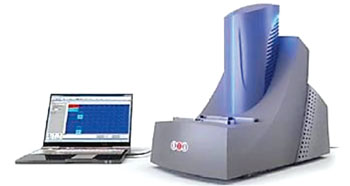New Methods Detect Early Onset of Alzheimer's Disease
By LabMedica International staff writers
Posted on 28 Jul 2016
New methods to examine the brain and spinal fluid heighten the chance of early diagnosis of Alzheimer's disease and this may have important implications for early detection of the disease, the choice of drug treatment and the inclusion of patients in clinical trials.Posted on 28 Jul 2016
It has become increasingly clear that, if the disease is to be treated successfully, it must be detected early, perhaps even before symptoms are evident. Thus, there is a great need for reliable diagnostic methods so that treatment to slow or prevent the disease can begin as early as possible.

Image: The Quickplex SQ 120 plate reader for electrochemiluminescence analyses (Photo courtesy of Meso Scale Discovery).
Scientists at the Karolinska Institute (Solna, Sweden) and their colleagues studied a population consisted of 243 subjects for whom Pittsburgh compound B imaging positron emission tomography (PiB PET) data and cerebrospinal fluid (CSF) data and samples were available. These were collected across seven European academic centers belonging to the Biomarkers for Alzheimer’s and Parkinson’s Disease (BIOMARKAPD) initiative. In addition, 13 with normal cognition were recruited from relatives and carers of patients.
Apolipoprotein E (APOE) genotyping was performed in a subset of 106 subjects via polymerase chain reaction (PCR) of genomic DNA extracted from EDTA-anticoagulated blood. Subjects were classified as ϵ4 allele carriers or non-carriers. Amyloid-β42, total tau, and phosphorylated tau were measured using commercially available sandwich enzyme-linked immunosorbent assays (ELISAs) (INNOTEST, Fujirebio-Europe, Gent, Belgium). Meso Scale Discovery electrochemiluminescence analyses (MSD, Rockville, MD, USA) and a novel mass spectrometry method for amyloid-β42 and amyloid-β40 were also performed.
The scientists found that the best fit was achieved when the amyloid level in the brain was compared with the ratio between the levels of amyloid42 and amyloid40 in the spinal fluid. Given this finding, the team hypothesized that the forms of β-amyloid found in the brain and spinal fluid are not completely identical. While technical factors cannot be excluded outright as contributing to measured amyloid-β42 and amyloid-β40 levels in CSF assays, even when run in the same time and place, continued discordance using centrally re-analyzed samples suggests that biological factors are also at play.
Agneta K. Nordberg. MD, PhD, a professor and the study coordinator said, “Interestingly, there was also a difference between the values measured in the brain and spinal fluid in a smaller group of patients. This may justify that, in some unclear cases, the diagnosis should include an amyloid PET scan to complement the cerebrospinal fluid sample. These findings are also important because it is increasingly common to perform amyloid-PET studies upon the inclusion of patients in new drug studies.” The study was published on July 7, 2016, in the journal Brain.
Related Links:
Karolinska Institute
Fujirebio-Europe
Meso Scale Discovery










 (3) (1).png)



